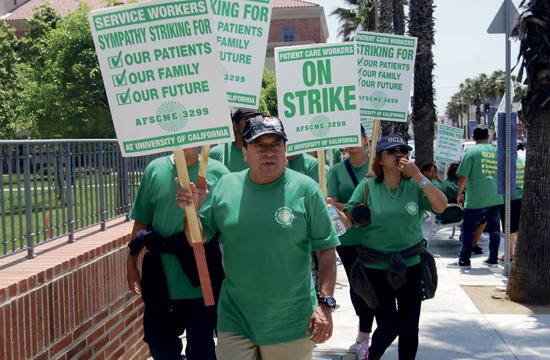SM-UCLA Medical Center Workers Strike

Health care professionals and workers walked the picket line in front of Santa Monica-UCLA Medical Center on Wednesday afternoon. Two unions have been trying to negotiate additional staffing needs at all University of California hospitals but came to an impasse earlier this week.
PARIMAL M. ROHIT / STAFF WRITER
Dozens of hospital employees lined Wilshire Boulevard and 16th Street on Tuesday and Wednesday as part of a coordinated strike and sympathy event involving health care workers at University of California-operated hospitals across the state, including Santa Monica-UCLA Medical Center, in an effort to increase staffing, update pension plans, and demand raises.
The two-day strike began at 4am May 21 and continued through Wednesday evening. Beyond the facility here in Santa Monica, hospital workers at other medical centers owned by UC Davis, UC Irvine, UCLA, UC San Diego, and UC San Francisco also participated in the strike.
In all, an estimated 30,000 health care workers either physically participated in the picket lines or symbolically supported the strike by not crossing it.
The strike occurred after one of two labor unions negotiating with the University of California – American Federation of State, County, and Municipal Employees, or AFSCME – failed to come to terms on a new deal for its represented employees. Members of the second labor union, University Professional and Technical Employees (UPTE), joined the strike in solidarity at the behest of their leadership.
More than 100 workers were actively picketing in front of Santa Monica-UCLA Medical Center just after lunch on Wednesday afternoon.
In anticipation of the strike, administrators at the 267-bed hospital on the corner of 16th Street and Wilshire Boulevard rescheduled nine surgeries for either right after the strike or for early next week.
News reports indicated as many as 120 surgeries system-wide were rescheduled because of the strike.
According to Chief Administrative Officer Paul Watkins, the Santa Monica facility was operating at about 82 percent occupancy because of the strike. Generally, the hospital’s occupancy reaches 94 percent during weekdays.
Watkins said the hospital admitted fewer patients this week knowing a full staff would not be available.
Emergency Room operations were unaffected by the strike.
A media representative from the Santa Monica-UCLA Medical Center told the Mirror about “550 replacement workers and redeployed administration staff … (filled) in for striking workers in positions ranging from housekeeping staff to respiratory therapists and nursing assistants.”
UCLA estimated the two-day strike cost the school’s medical facilities more than $5 million, including lost revenue and expenditures for replacement workers.
One employee participating in the picket line told the Mirror she and her colleagues were striking to ensure optimal patient care and safety.
“I hope to achieve safe staffing for Santa Monica-UCLA hospital. We’re a world-class hospital and we want to keep it that way,” Annette Norwood-Dunlap, a healthcare professional at the Santa Monica-UCLA Medical Center, told the Mirror.
Norwood-Dunlap added because certain departments have been short- or under-staffed, various health professionals at the hospital have not been able to provide optimal care. For example, she stated there have been multiple cases of elderly care patients falling, something she believes could be prevented with more staffing.
To give an example, Norwood-Dunlap tried to quantify what she viewed as “world-class care” and compared her view to what she believed was UCLA’s agenda.
“(If) you have a floor of 30 patients, you usually have six care partners on that floor. But what UCLA would want to do is … take six care partners down to two or three,” Norwood-Dunlap told the Mirror.
Meanwhile, Owen Li, a representative of AFSCME, elaborated on why the strike, even if it was only for two days, was so important.
“There’s been thousands of people statewide who have joined the strike, as well as hundreds here at the Santa Monica hospital. People see in their day-to-day lives the impact that UC’s reckless cost-cutting has on patient care,” Li told the Mirror. “What we hope to achieve is for the UC to take patient care seriously. For years we’ve raised the problems that we’ve been seeing with UC cutting corners and prioritizing lavish salaries for executives [instead of] investing in patient safety.”
Li added that 97 percent of AFSCME members voted to strike.
AFSCME and UPTE represent about 5,000 UCLA Health System employees.
A Superior Court judge in Sacramento issued an injunction on May 20, one day prior to the strike, preventing a handful of union employees from participating in the two-day strike because a large walkout could threaten public health and safety. Specifically, union employees from the neonatal and pediatric intensive care units as well as burn units were prohibited from striking, according to news reports.
[Source]: Santa Monica Mirror


